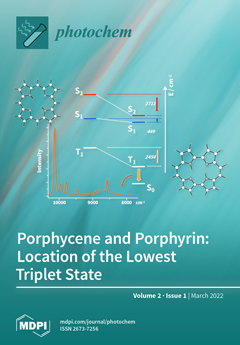Photodynamic therapy (PDT) is a promising treatment option that ablates cancerous cells and tumors via photoinduced sensitization of singlet oxygen. Over the last few decades, much work has been devoted to the development of new photochemotherapeutic agents for PDT. A wide variety of macrocyclic tetrapyrrole based photosensitizers have been designed, synthesized and characterized as PDT agents. Many of these complexes have a variety of issues that pose a barrier to their use in humans, including biocompatibility, inherent toxicity, and synthetic hurdles. We have developed a non-traditional, non-cyclic, and non-aromatic tetrapyrrole ligand scaffold, called the biladiene (
DMBil1), as an alternative to these traditional photosensitizer complexes. Upon insertion of a heavy atom such as Pd
2+ center,
Pd[DMBil1] generates singlet oxygen in substantial yields (Φ
Δ = 0.54, λ
exc = 500 nm) when irradiated with visible light. To extend the absorption profile for
Pd[DMBil1] deeper into the phototherapeutic window, the tetrapyrrole was conjugated with alkynyl phenyl groups at the 2- and 18-positions (
Pd[DMBil2-PE]) resulting in a significant redshift while also increasing singlet oxygen generation (Φ
Δ = 0.59, 600 nm). To further modify the dialkynyl-biladiene scaffold, we conjugated a 1,8-diethynylanthracene with to the
Pd[DMBil1] tetrapyrrole in order to further extend the compound’s π-conjugation in a cyclic loop that spans the entire tetrapyrrole unit. This new compound (
Pd[DMBil2-P61]) is structurally reminiscent of the P61 Black Widow aircraft and absorbs light into the phototherapeutic window (600–900 nm). In addition to detailing the solid-state structure and steady-state spectroscopic properties for this new biladiene, photochemical sensitization studies demonstrated that
Pd[DMBil2-P61] can sensitize the formation of
1O
2 with quantum yields of Φ
Δ = 0.84 upon irradiation with light λ = 600 nm. These results distinguish the
Pd[DMBil2-P61] platform as the most efficient biladiene-based singlet oxygen photosensitizer developed to date. When taken together, the improved absorption in the phototherapeutic window and high singlet oxygen sensitization efficiency of
Pd[DMBil2-P61] mark this compound as a promising candidate for future study as an agent of photodynamic cancer therapy.
Full article





